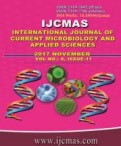


 National Academy of Agricultural Sciences (NAAS)
National Academy of Agricultural Sciences (NAAS)

|
PRINT ISSN : 2319-7692
Online ISSN : 2319-7706 Issues : 12 per year Publisher : Excellent Publishers Email : editorijcmas@gmail.com / submit@ijcmas.com Editor-in-chief: Dr.M.Prakash Index Copernicus ICV 2018: 95.39 NAAS RATING 2020: 5.38 |
Essential oils are plant-based volatile oils with strong aromatic components (Younis et al., 2008). Jasmine fragrance gives a feeling of optimism, confidence and euphoria and is helpful against depression, nervous exhaustion and stress related conditions. Three species of jasmine viz., Jasminum sambac, Jasminum auriculatum and Jasminum grandiflorum is cultivated in a commercial scale (Rimando, 2003; Green and Miller, 2009). Among these, the flowers of Jasminum auriculatum are white, sweet scented, borne in pubescent compound many flowered cymes. In this study, Jasminum auriculatum concrete extraction was carried out by solvent extraction with hexane for three varieties viz., CO-1 mullai, CO-2 mullai and Parimullai which is cultivated in South India. The chemical composition of the concrete was analysed by gas chromatography- mass spectrometry (GC-MS). The results showed that percentage yield of concrete were in the range of 0.28 to 0.36% per cent. The major chemical components detected were 17-Pentatriacontene; Octadecane, 3-ethyl-5-(2-ethylbutyl); 11-Pentanol, 4-methyl-2-propyl-. The result of this study showed that the GC-MS study is selective, rapid and efficient for the identification of volatile components and composition variations.
 |
 |
 |
 |
 |